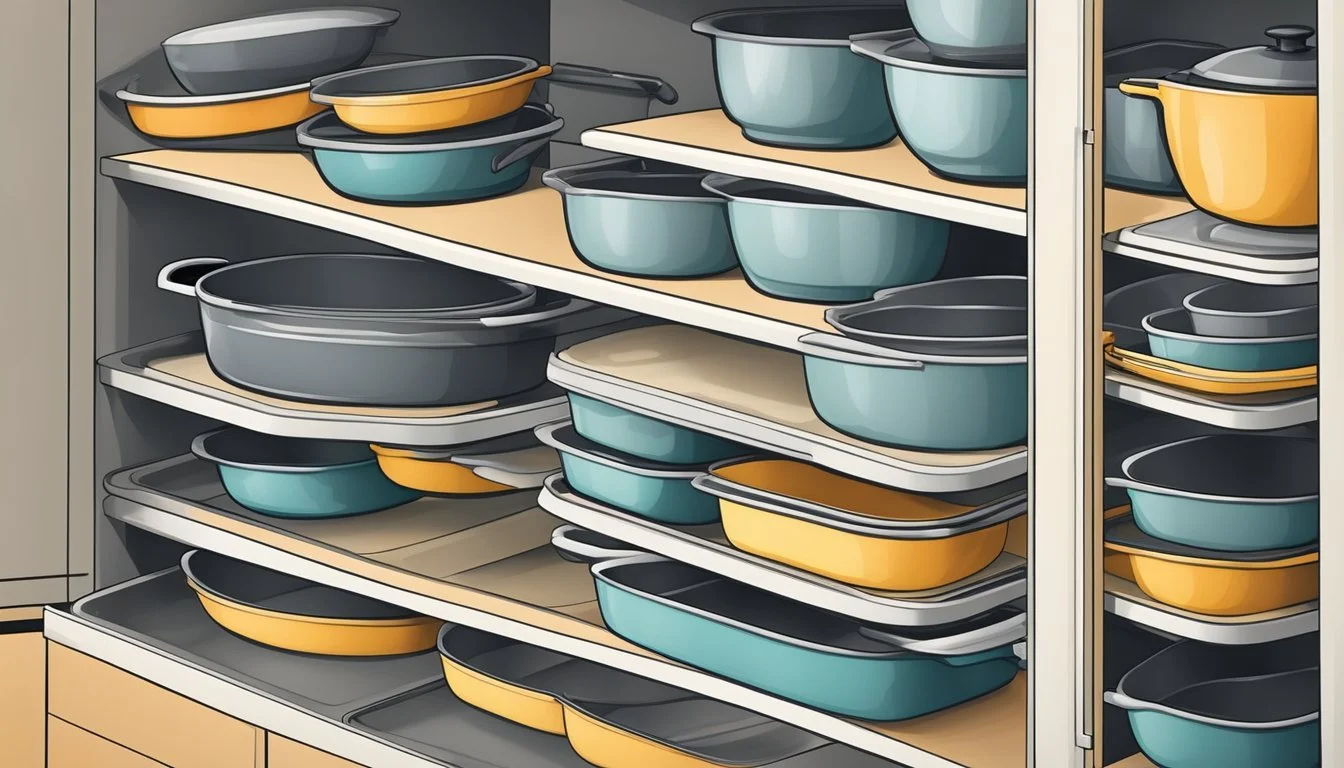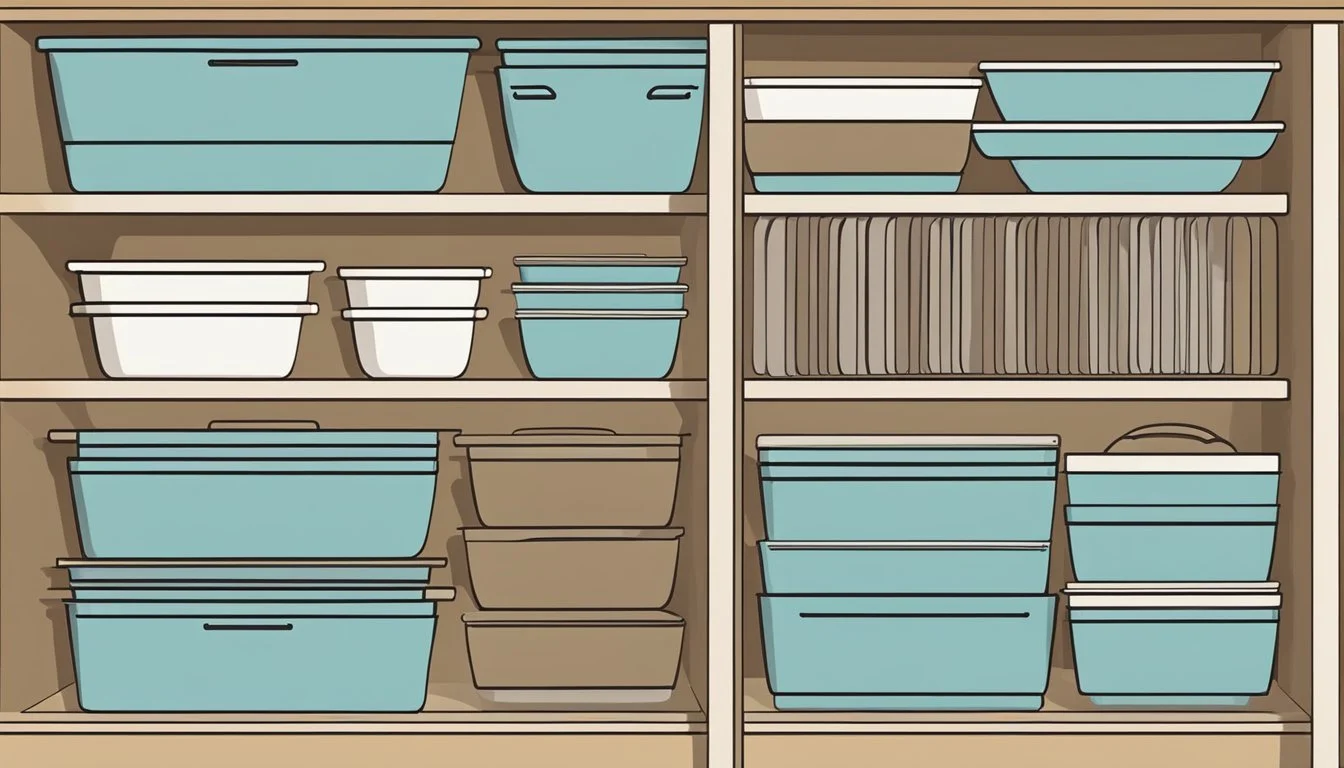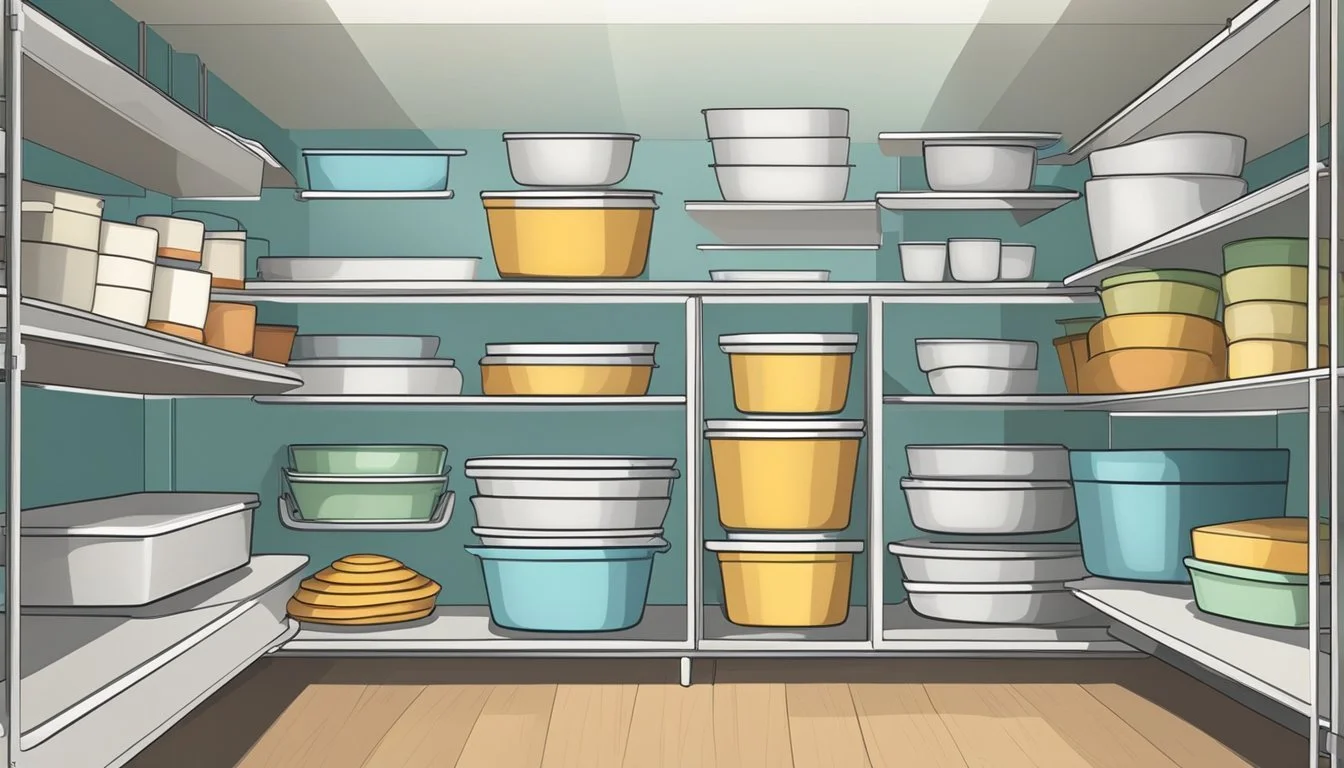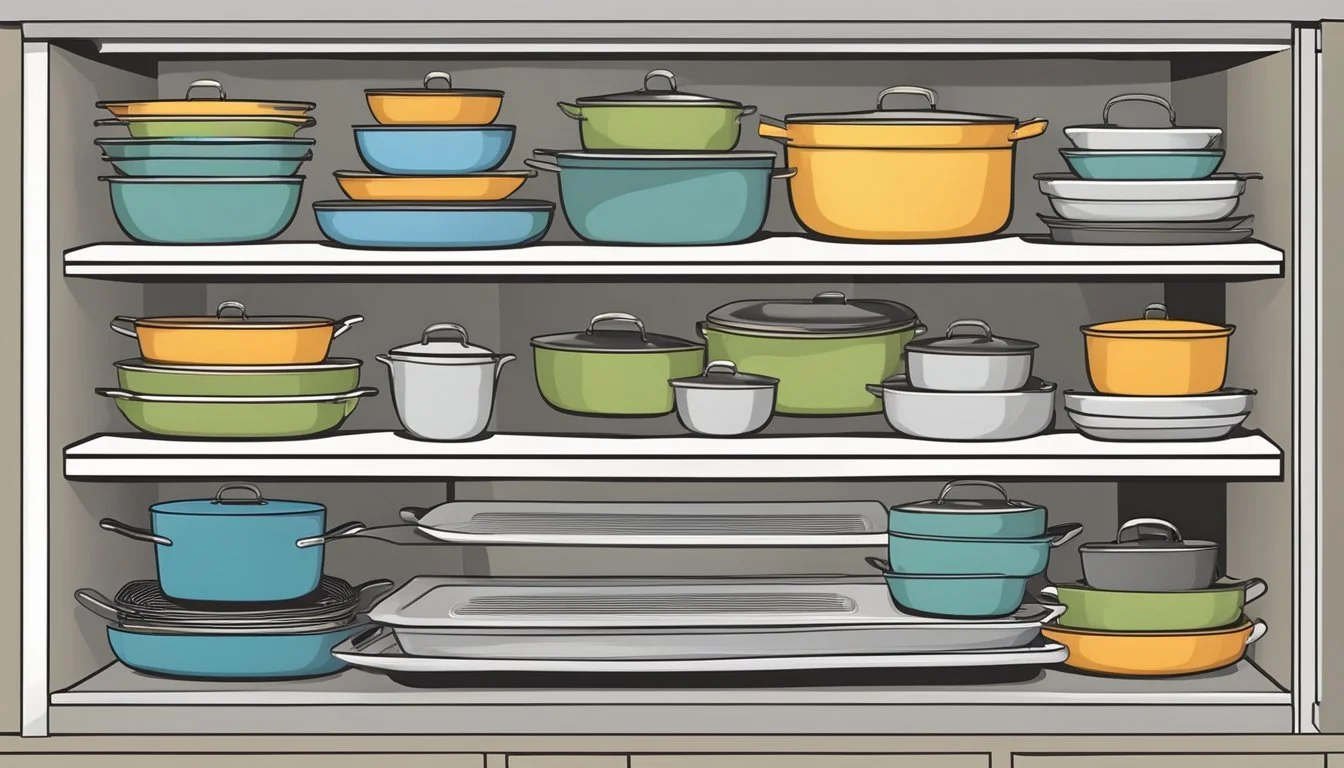The Best Way to Store Your Roasting Pans and Baking Dishes
Space-Saving Tips for Your Kitchen
Storing roasting pans and baking dishes efficiently can transform the functionality of any kitchen. Given that these kitchen essentials come in various shapes and sizes, finding the right storage solution keeps them accessible and in good condition. Optimal storage methods prevent clutter, minimize damage from stacking, and can even provide a visual appeal to the kitchen space.
Using vertical storage stands as one of the most robust ways to manage these items. This approach allows for easier access, as each pan or dish can be retrieved without having to move others out of the way. Additionally, it helps in keeping them separated, which is beneficial for non-stick surfaces or other delicate materials that could be scratched or damaged.
Inclusion of adjustable dividers in cabinets or drawers offers a customizable storage solution tailored to the unique collection of bakeware each individual possesses. Drawers with purpose-built sections ensure that heavy items like cast iron skillets or ceramic dishes are secure, while tension rods can be a simple and adjustable means to create compartments within cabinets. Such tailored solutions not only maintain the quality of the bakeware but also contribute to a more orderly and efficient kitchen workflow.
Understanding Kitchen Storage
Effective organization maximizes efficiency and accessibility in the kitchen. It ensures that roasting pans and baking dishes are stored in a way that complements the kitchen layout and the cook's workflow.
Assessing Your Space and Storage Needs
One begins by evaluating the available kitchen space, particularly focusing on kitchen cabinets and any open areas that can be adapted into storage zones. Small kitchens require creative solutions to use every inch wisely. A thorough inventory determines the size and number of items needing storage, while considering kitchen layout dictates the storage approach.
Assess kitchen cabinet dimensions
Inventory all baking equipment
Determine storage zone based on frequency of use and kitchen layout
The Importance of Organizing Baking Equipment
Organizing baking equipment in a kitchen is critical for several reasons:
Efficiency: Categorizing items by type or use creates a streamlined experience.
Protection: Proper storage protects equipment from damage.
Safety: Minimizes the risk of accidents by reducing clutter.
Arrange equipment by size and shape within cabinets
Utilize vertical dividers for baking sheets and pan organizers for deeper dishes
Consider adding hooks or overhead racks for frequently used items
Implementing these storage ideas ensures that one can find the right tools quickly, maintain the integrity of their equipment, and enjoy a safer cooking environment.
Innovative Storage Solutions
Storage of bakeware like roasting pans and baking dishes can significantly benefit from innovative organization methods. By maximizing unused spaces and repurposing traditional storage concepts, one may create an efficient kitchen environment.
Utilizing Vertical Space for Bakeware
Vertical storage solutions transform how one organizes bakeware, utilizing spaces that are often overlooked. Tension rods installed inside pantry doors or upper cabinets can serve as dividers for baking sheets and cutting boards, offering quick access and visual tidiness. A pull-out with vertical dividers can be fitted within lower cabinets, making it easier to sort and store roasting pans and trays upright. This not only saves space but also reduces wear and scratches from stacking.
Tension Rods: Install them in a pantry or cabinet for a simple and adjustable solution.
Pull-Outs with Dividers: Retrofit lower cabinets with vertical compartments for easy access.
Maximizing Cabinet and Drawer Space
Optimizing cabinet and drawer space through custom organizers provides an orderly stash for baking essentials. Deep drawers with built-in or adjustable sections are ideal for sorting baking dishes by size and shape. Retrofit cabinets with slide-out racks or wire baskets enable the stowing of pans that are used less frequently. Moreover, over-door cabinet organizers can preserve precious shelf space while keeping bakeware within reach.
Deep Drawer Dividers: Custom-built or adjustable, these keep dishes organized.
Slide-Out Racks: Install in cabinets to efficiently store and retrieve infrequently used pans.
Creative Use of Wall and Ceiling Area
Walls and ceilings offer vast storage potentials often left untapped. A DIY pegboard mounted on a wall fitted with hooks provides a flexible and modifiable storage system. One could hang frequently used pans on the pegboard, adapting the layout over time as needed. Under-utilized ceiling space can also host a hanging pot rack, freeing up cabinet space while adding an aesthetic aspect to the kitchen.
Wall-Mounted Pegboards: Fit hooks to hang and organize bakeware.
Ceiling Pot Racks: A stylish and practical solution to store roasting pans overhead.
Organizing Tools and Accessories
When storing roasting pans and baking dishes, the right organizers can streamline the process, ensuring every item is easily accessible and neatly stored.
Selecting the Right Organizers
Selecting appropriate organizers is paramount to maintain order within kitchen cabinets. The size and shape of your bakeware should guide your choice of organizers, such as vertical dividers for baking sheets or deep baskets for bulky roasting pans.
Organizers for Pans, Dishes, and Lids
Pans and Dishes: A pan organizer can be invaluable for neatly stacking assorted pans while permitting individual access. Look for adjustable or tiered designs to accommodate a variety of sizes.
Lids: A lid organizer or file organizer ensures that lids are not lost or cluttering space. They can be positioned vertically to match the corresponding pans.
Adapting Organizers for Different Bakeware
Flexible storage solutions allow for adaptation to various bakeware types. A lazy susan can house smaller items like ramekins, while a pegboard with hooks offers a customizable wall storage that can fit any kitchen layout and size of bakeware.
Incorporating Organizers into Kitchen Zones
Bakeware should be placed in designated kitchen zones, such as near the oven for efficiency. Utilize baskets for grouping similar items and command hooks for hanging accessories within reach. Install vertical dividers in lower cabinets for trays and racks to enhance visibility and accessibility.
Tips for Storing Common Baking Items
Storing baking items properly ensures longevity and maintains their quality for consistent baking results. This section provides detailed advice on the best ways to keep various bakeware items in good condition.
Strategies for Cookie Sheets and Baking Pans
When storing cookie sheets and baking pans, one should focus on maintaining their shape and surface. These flat items are ideally stored vertically to save space and prevent scratching. Using a filing system, like a rack or organizer, allows for easy access and minimizes contact that could lead to scratches or damage. It's important to ensure that they are completely dry before storing to prevent rusting, especially for non-stainless materials.
Storing Muffin Tins and Cookie Cutters
Muffin tins present a bit of a challenge due to their depth and shape. They stack well, but one must be cautious not to nest them too tightly, as this could warp the tins or make them difficult to separate later. For cookie cutters, using a clear storage box with dividers or dedicating a small drawer provides organization and protects delicate shapes. Hanging cookie cutters on a pegboard is also an excellent way to have them at hand without cluttering drawers.
Proper Storage of Baking Dishes and Casserole Dishes
Baking dishes and casserole dishes require careful handling due to their weight and potential for chipping. Stacking them is an option, but always with cushioning layers of soft material, like towels or felt separators, to prevent scratching and chipping. For glass or ceramic dishes, keeping them in a stable, low-traffic cupboard helps to avoid accidental drops or bumps. If space allows, they can also be stored on their edge like plates in a rack, to minimize the required storage space.
Maintaining and Protecting Your Bakeware
One must address both the avoidance of damage and the accumulation of dust, as well as foster ease of access to ensure the longevity and functionality of their bakeware. Proper storage solutions not only preserve the condition of each piece but also streamline the baking process.
Avoiding Damage and Dust Accumulation
When storing roasting pans and baking dishes, it's essential to keep them in an environment where they are less likely to incur scratches or dents. Weight plays a critical role; heavier items should be placed on lower shelves or in bottom cabinets to prevent accidents and make handling easier. To protect your dish collection from dust, one might consider using cabinet doors or breathable covers. Storage systems such as vertical dividers can keep items separated and prevent them from nesting too tightly, which can cause chipping or cracking.
Tips for Avoiding Damage:
Store heaviest items at the bottom
Use shelf liners to cushion items
Install dividers to prevent shifting
Avoid stacking which can cause pressure and damage
Dust Prevention Strategies:
Utilize cabinets with doors
Implement breathable covers to ward off dust
Regularly clean the storage area
Ensuring Accessibility and Ease of Use
The insights of a professional organizer often highlight the importance of accessibility. Roasting pans and baking dishes should be arranged so that one can retrieve them without rearranging the entire cabinet—this can be managed through the strategic use of racks and clear organizational systems. By categorizing bakeware by type or frequency of use, one can diminish the time spent searching and increase efficiency. As part of kitchen organizing, ensuring every piece of bakeware has its designated place keeps the area orderly and functional.
Accessibility Solutions:
Sort items by type (e.g., roasting pans separate from baking dishes)
Prioritize frequently used items at the front or at an arm's reach
Ease of Use:
Label shelves or zones if necessary
Invest in pull-out drawers for hard-to-reach areas
Space-Enhancing Techniques for Small Kitchens
Maximizing storage in small kitchens often means getting creative and considering every square inch of available space. This section discusses specific solutions that can help in organizing roasting pans and baking dishes effectively.
Implementing Vertical Dividers and Trays
Vertical dividers optimize cabinet space by allowing baking dishes and roasting pans to be stored upright, much like one would file books on a shelf. These can be integrated into existing cabinets or added as standalone racks. Slim trays can also slide next to the refrigerator or in narrow cabinets, providing additional layers of storage.
Using Rolling Carts and Portable Organizers
Rolling carts offer flexible storage solutions that can be moved as needed. They typically come with multiple levels, allowing for the categorization of kitchen items. Portable organizers with tiered shelving can also be utilized to ensure that everything from baking dishes to utensils are neatly sorted and accessible.
Underutilized Spaces: Toe Kick and Pull-Out Drawers
Toe kick drawers make use of the space beneath lower cabinets and can be used to stash away less frequently used roasting pans. Pull-out drawers, on the other hand, can be custom fitted to any cabinet. They provide full visibility and easy access, thereby ensuring that every available inch of a small kitchen is put to good use.
Advanced Kitchen Organization Tips
Effective kitchen organization transcends mere tidiness; it's an intricate dance of placement and accessibility. The following strategies pivot on zone creation and imaginative reuse of items to transform chaos into a streamlined kitchen environment.
Zone-Based Organizing Philosophy
Creating zones within a kitchen underscores the maximization of efficiency. Storage zones should be established based on the frequency and context of use. For instance, one might designate a specific area for roasting pans and baking dishes, ideally near the oven for easy access during meal prep. This could involve dedicating a cabinet shelf expressly for these items or using a deep drawer outfitted with dividers.
List of Potential Zones:
Preparation Zone: Where cutting boards and mixing bowls thrive.
Cooking Zone: Home for pots, pans, and baking dishes.
Serving Zone: Storage space for platters and serving utensils.
Cleaning Zone: Location of dish soap, sponges, and trash bags.
Leveraging Upcycling for Storage
Upcycling transforms everyday items into resourceful storage solutions for roasting pans and baking dishes. An individual may repurpose old file holders to neatly stack pans on their sides, making them more accessible and reducing clutter. Similarly, mounting pre-loved bookshelves on their sides can offer sectional storage spaces, perfect for sliding in baking dishes.
Table of Upcycling Ideas:
Upcycled Item New Use for Storage File Holders Upright pan separators in cabinets Bookshelves Horizontal racks for baking dishes Tension Rods Adjustable dividers in drawers
Implementing a zone-based organizing philosophy alongside inventive upcycling practices can monumentally enhance the functionality of one’s kitchen, making it both a joy to navigate and operate.
Selecting Storage Features for New Kitchens
When designing a new kitchen, efficiency and accessibility are paramount, especially for storing bakeware like roasting pans and baking dishes.
Design Considerations for Bakeware Storage
Kitchen Layout: The layout should offer easy access to bakeware, often used in ovens situated at waist height. It's advisable to locate storage near the oven for seamless kitchen workflows. Storage for heavy items like roasting pans should be positioned lower to minimize lifting, while baking dishes benefit from being stored at a more reachable level, to avoid bending.
Storage Features: Consider drawers versus cupboard storage. Deep, wide drawers fitted with adjustable dividers can efficiently house various pans and dishes and prevent them from toppling over. Alternatively, vertical slots within cupboards can make efficient use of space and simplify retrieval.
Incorporating Built-In Storage Solutions
Pantry Shelf: Within a pantry, adjustable shelving systems allow for customization based on the height of bakeware, which can vary greatly. Shelving should be sturdy to cope with the weight and crafted from materials that resist scratches and damage.
Built-In Storage Features: Customization often leads to better kitchen organization. Integrated storage features like pull-out racks, vertical dividers, and pegboard systems help keep items separated and prevent clutter. These features also make it possible to see all available bakeware at a glance.
When selecting these features, homeowners should consider the durability and weight capacity of the storage solutions to ensure longevity and safety. They should also tailor these features to the types of bakeware they use most frequently, ensuring a personalized and high-functioning kitchen space.
Consulting with Professionals
When it comes to maximizing kitchen storage efficiency, consulting with a professional can provide tailored solutions for organizing your roasting pans and baking dishes. Their expertise can transform cluttered cabinets into easily accessible spaces.
Hiring a Professional Organizer
A professional organizer specializes in decluttering and systematizing home and office spaces. In the kitchen, they assess the available space, your specific storage needs, and the best methods for organizing your cookware. Here are action points they might recommend:
Utilizing vertical storage racks for easy access to roasting pans and baking dishes.
Implementing custom drawer dividers to keep items separated and prevent damage.
The Role of Commission in Kitchen Design
When redesigning a kitchen, commission may play a significant role when working with designers or custom cabinetry companies. They:
Often work on a commission basis, affecting the cost and design suggestions offered to you.
Aim to integrate storage solutions that are both aesthetically pleasing and functional, possibly recommending built-in cabinet organizers for your bakeware.





